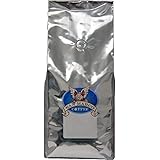Achieving the perfect French Press coffee doesn’t have to be a mystery. As the video above demonstrates, there’s a straightforward method to transform your morning routine into a delightful ritual. By focusing on a few key elements, you can consistently brew a rich, flavorful cup that stands out.
This guide expands on those essential steps, offering deeper insights and practical tips to ensure your French Press truly shines. We’ll delve into why each stage matters, helping you understand the science behind your delicious brew.
Unlock the Secret to Perfect French Press Coffee Every Time
Brewing truly exceptional coffee begins long before the water touches the beans. The foundation of your perfect cup lies in the quality of your ingredients and how they are prepared.
The Foundation: Quality Beans and the Right Grind for French Press
Choosing Quality Whole Beans
The video rightly emphasizes using whole beans, and for good reason. Whole beans retain their freshness and aromatic compounds far better than pre-ground coffee.
Imagine if you bought pre-cut vegetables versus cutting them yourself just before cooking; the fresh cut ones always taste better. This principle applies directly to coffee.
When coffee is ground, its surface area drastically increases, exposing it to more oxygen. This acceleration of oxidation leads to a rapid loss of volatile oils and flavors, resulting in a duller, less vibrant cup.
To ensure optimal freshness, look for beans with a roast date, not just a “best by” date. Coffee is typically best enjoyed within 1-4 weeks of roasting, depending on the roast level.
The Art of the Coarse Grind
A crucial factor for perfect French Press coffee is the grind size. As highlighted in the video, a coarse grind is paramount.
This texture, resembling sea salt or coarse sand, is essential for proper extraction. An overly fine grind will lead to over-extraction, resulting in a bitter, astringent, and muddy coffee.
Conversely, if the grind is too coarse, your coffee will be under-extracted, tasting weak, sour, and lacking depth. A burr grinder, whether electric or hand-cranked, is recommended because it grinds coffee uniformly.
Blade grinders, by contrast, chop beans inconsistently, creating both fine dust and large chunks. This inconsistency makes it impossible to achieve balanced extraction, leading to an inferior cup.
Precision Brewing: Ratios, Water, and Agitation for French Press
Mastering the Coffee-to-Water Ratio
The video provides a fantastic starting point: 70 grams of beans per 800 grams of water. This translates roughly to a 1:11.4 ratio, which is robust and flavorful for the French Press method.
This ratio is a great baseline for about 2-3 standard cups of coffee. Using a kitchen scale for both coffee and water is the most accurate way to ensure consistency.
Imagine if you always cooked without measuring; results would vary wildly. Weighing your ingredients takes the guesswork out of brewing, allowing you to replicate delicious results.
You can adjust this ratio slightly to suit your personal preference. For a stronger brew, increase the coffee slightly (e.g., 75g per 800g water); for a lighter cup, decrease it.
Optimal Water Temperature
“Just boiled water” is a good directive, but precision takes it further. The ideal water temperature for brewing coffee is typically between 195°F and 205°F (90°C and 96°C).
Boiling water directly (212°F or 100°C) can scald the coffee grounds, leading to a bitter taste. Letting the water sit for about 30-60 seconds after boiling brings it into the perfect brewing range.
This ensures optimal extraction of soluble flavors without burning the delicate compounds. A thermometer can help, but a short wait after the boil is usually sufficient.
The Role of Agitation
After adding your ground coffee and hot water, a gentle stir, as suggested in the video, is beneficial. This initial agitation ensures all coffee grounds are fully saturated with water.
This process, often called “blooming,” allows the coffee to release trapped carbon dioxide, which can hinder proper extraction if not released. A chopstick or spoon works perfectly for this.
Ensuring every ground particle is wet promotes an even and efficient extraction process. This simple step contributes significantly to the overall balance and flavor of your cup.
The Crucial Steeping and the “Super Secret” Step for Your French Press
The Perfect Steep Time
The four-minute steeping time mentioned in the video is a widely accepted standard for French Press coffee. This duration allows sufficient time for the water to extract the desirable flavors, aromas, and body from the coarse grounds.
Steeping for too short a time results in under-extracted coffee, tasting thin and sour. Conversely, exceeding four minutes can lead to over-extraction, making the coffee bitter and harsh.
While four minutes is ideal, feel free to experiment slightly based on your preference and the specific beans you’re using. Some darker roasts might benefit from a slightly shorter steep, while lighter roasts could go a bit longer.
The Game-Changing Skimming Technique
This “super secret step” from the video is truly a revelation for many French Press users. After the four-minute steep, gently skim the layer of floating grounds and foam from the surface using a couple of spoons.
These fine particles are often responsible for the “muddy” texture and lingering bitterness sometimes associated with French Press coffee. They can easily slip past the mesh filter and into your cup.
Removing them before pressing helps clarify the brew significantly, enhancing both taste and mouthfeel. It reduces the chance of over-extraction from these smaller particles, leading to a cleaner, brighter cup.
Imagine if you could remove all the impurities from a clear broth just before serving; that’s the effect skimming has on your coffee. This simple yet effective technique elevates your perfect French Press coffee to new heights.
Elevating Your French Press Experience Beyond the Basics
Pouring and Enjoying Your Liquid Gold
Once you’ve skimmed the grounds, carefully and steadily depress the plunger. You should feel a smooth, gentle resistance. If it’s too difficult, your grind might be too fine; if it plunges too easily, it might be too coarse.
After pressing, pour your coffee immediately into your favorite mug. Leaving the coffee to sit in the French Press, even with the plunger down, will continue the extraction process due to residual grounds, leading to a bitter taste.
If you have leftover coffee, transfer it to an insulated carafe to maintain its temperature and stop further extraction. Savoring that first sip of perfectly brewed French Press is a reward for your careful efforts.
Maintenance and Troubleshooting
Regular cleaning of your French Press is vital to prevent oil buildup and stale coffee residue, which can taint future brews. Disassemble the plunger and rinse all components thoroughly after each use.
For deeper cleaning, occasional soaking in warm soapy water or a specialized coffee cleaner can remove stubborn oils. If your coffee tastes consistently bitter, check your grind size and steep time.
If it’s weak or sour, your grind might be too coarse or your water temperature too low. Understanding these common issues will help you refine your technique and continuously brew perfect French Press coffee.







